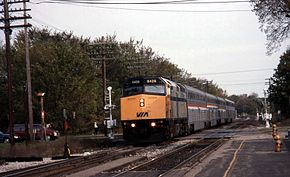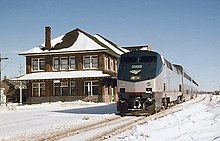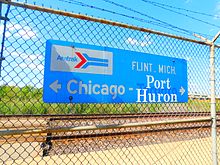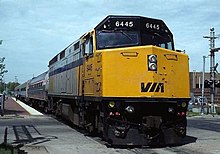
The Capitol Limited is a daily Amtrak train between Washington, D.C., and Chicago, running 764 miles (1,230 km) via Pittsburgh and Cleveland. Service began in 1981 and was named after the Baltimore and Ohio Railroad's Capitol Limited which ended in 1971 upon the formation of Amtrak. It carries the Amtrak train numbers 29 and 30, which were previously assigned to the discontinued National Limited.

The Grand Trunk Railway was a railway system that operated in the Canadian provinces of Quebec and Ontario and in the American states of Connecticut, Maine, Michigan, Massachusetts, New Hampshire, and Vermont. The railway was operated from headquarters in Montreal, Quebec, with corporate headquarters in London, United Kingdom. It cost an estimated $160 million to build. The Grand Trunk, its subsidiaries, and the Canadian Government Railways were precursors of today's Canadian National Railway.

The Lake Shore Limited is an overnight Amtrak intercity passenger train that runs between Chicago and either New York City or Boston via two sections east of Albany. The train began service in 1975; its predecessor was Amtrak's Chicago–New York Lake Shore, which operated during 1971–72. It is named for the New York Central (NYC) Lake Shore Limited, which was discontinued in 1956, and uses the NYC's former main line, part of which is now the Empire Corridor.

The Grand Trunk Western Railroad Company is an American subsidiary of the Canadian National Railway operating in Michigan, Illinois, Indiana, and Ohio. Since a corporate restructuring in 1971, the railroad has been under CN's subsidiary holding company, the Grand Trunk Corporation. Grand Trunk Western's routes are part of CN's Michigan Division. Its primary mainline between Chicago and Port Huron, Michigan serves as a connection between railroad interchanges in Chicago and rail lines in eastern Canada and the Northeastern United States. The railroad's extensive trackage in Detroit and across southern Michigan has made it an essential link for the automotive industry as a hauler of parts and automobiles from manufacturing plants.

The Cardinal is a long distance passenger train operated by Amtrak between New York Penn Station and Chicago Union Station via Philadelphia, Washington, D.C., Charlottesville, Charleston, Huntington, Cincinnati, and Indianapolis. Along with the Capitol Limited and Lake Shore Limited, it is one of three trains linking the Northeast and Chicago. Its 1,146-mile (1,844 km) trip between New York and Chicago takes 281⁄4 hours.

Michigan Services are three Amtrak passenger rail routes connecting Chicago, Illinois with the Michigan cities of Grand Rapids, Port Huron, and Detroit, and stations en route. The group is a component of the Midwest Regional Rail Initiative.

Malton GO Station is a train and bus station in the GO Transit network, located near Toronto Pearson International Airport, in the community of Malton in Mississauga, Ontario, Canada. It is a stop on the Kitchener line, and is a flag stop for Via Rail trains operating between Toronto, London and Sarnia.

The St. Clair Tunnel is the name for two separate rail tunnels which were built under the St. Clair River between Sarnia, Ontario and Port Huron, Michigan. The original, opened in 1891 and used until it was replaced by a new larger tunnel in 1995, was the first full-size subaqueous tunnel built in North America. It is a National Historic Landmark of the United States, and has been designated a civil engineering landmark by both US and Canadian engineering bodies.

Georgetown GO Station is a railway station served by GO Transit's Kitchener line and Via Rail's Toronto-Sarnia train. It is located west of Mountainview Road North at 55 Queen Street in Georgetown, Ontario, Canada.

Kitchener station is a railway station located in Kitchener, Ontario, Canada, slightly to the northeast of downtown Kitchener, at 126 Weber Street West, near the corner of Victoria Street. It is a heritage building containing a waiting room and ticket counter built beside a set of tracks also used as a freight yard. A separate building to the east of the passenger area, originally built in 1925 as a freight building, now serves as the headquarters for the Goderich–Exeter Railway.

Durand Union Station is a historic train station in Durand, Michigan. The station, which now serves Amtrak Blue Water trains, was originally a busy Grand Trunk Western Railroad and Ann Arbor Railroad station, as well as a local office for Grand Trunk Western, from its construction in 1903 until 1974. It is currently owned by the city of Durand and leased by Durand Union Station, Inc. a nonprofit organization dedicated to the preservation, restoration, and maintenance of the building and its surrounding property.
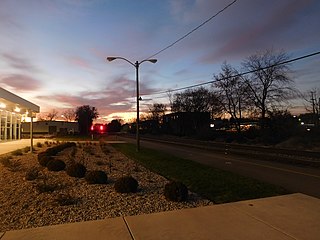
Capital Area Multimodal Gateway, also known as East Lansing station, is an intermodal transit station in East Lansing, Michigan. Operated by the Capital Area Transportation Authority (CATA), it is served by Amtrak's Blue Water passenger train, local buses, and intercity buses. It opened in 2015 to replace a nearby Amtrak and bus station operating since 1974.

The Wolverine is a higher-speed passenger train service operated by Amtrak as part of its Michigan Services. The 304-mile (489 km) line provides three daily round-trips between Chicago and Pontiac, Michigan, via Ann Arbor and Detroit. It carries a heritage train name descended from the New York Central.

The Blue Water is a higher-speed passenger train service operated by Amtrak as part of its Michigan Services. The 319-mile (513 km) route runs from Chicago, Illinois, to Port Huron in Michigan's Blue Water Area, for which the train is named. Major stops are in Kalamazoo, Battle Creek, East Lansing, and Flint.

Battle Creek Transportation Center is an intermodal station in Battle Creek, Michigan, used by Amtrak, Indian Trails and Greyhound Lines. It is at the split between the routes of Amtrak's Blue Water and Wolverine passenger trains. The International Limited, which had started in 1982 as joint operation by Via Rail and Amtrak between Chicago and Toronto, was discontinued in 2004.

Flint station is an inter-modal transportation center in Flint, Michigan. It is served by Amtrak's Blue Water route, and doubles as the intercity bus station for Amtrak Thruway and Indian Trails, as well as the local city bus service, the Flint Mass Transportation Authority, who owns the station. The station was built as part of the Amtrak Standard Stations Program.
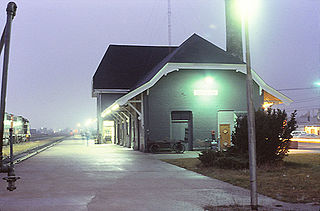
Sarnia station is a Via Rail train station in Sarnia, Ontario, Canada. It is the western terminus for Via Rail trains running from Toronto through southwestern Ontario. The unstaffed station is wheelchair accessible. The station includes vending machines, washrooms, a pay phone, and a medium-sized waiting area.
The Twilight Limited was a named passenger train in the United States which initially operated between Chicago, Illinois, and Detroit, Michigan. The New York Central Railroad introduced the train in 1926, and it continued until the formation of Amtrak in 1971, although it lost its name in 1967. Amtrak renamed the train St. Clair, feeling that the name "Twilight Limited" had undesirable connotations and imagery for a company trying to save passenger rail service. Amtrak revived the name in 1976 for a new train frequency on the Chicago–Detroit corridor, and kept the name until all trains on that corridor were renamed Wolverine in 2004.

The Maple Leaf was a passenger train pool operated by the Canadian National and the Grand Trunk Western Railroad between Chicago, Illinois and Toronto, Ontario. It operated from 1927 to 1971. The train took its name from the maple leaf, the national symbol of Canada. The Maple Leaf was one of many trains discontinued when Amtrak began operations in 1971, and is unrelated to the Maple Leaf which Amtrak now operates between Toronto and New York City. The train operated on Canadian National railroad territory through Ontario, but west of Lake Huron it operated via Grand Trunk Railroad.
The Canadian and later, Canadian-Niagara, was the longest running named international train from Chicago to Upper Canada via Detroit, for its first two decades running to Montreal. This overnight train was operated by the Michigan Central Railroad from Chicago to Detroit, and in a pool arrangement, it operated over Canadian Pacific Railway tracks and used the same train number from Detroit eastward. The train would carry a second section, bound, variously for Buffalo or New York City via Buffalo.
